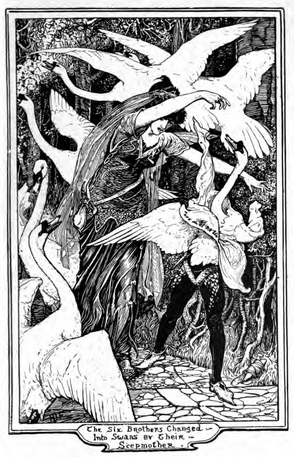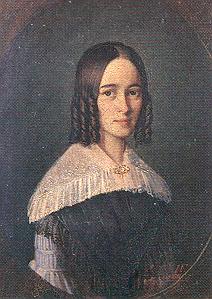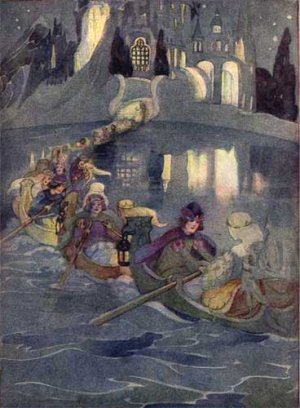 Americans have...or used to have...a saying that behind every successful man was a strong woman. Valerie Paradiz' study is about the women who provided the Brothers Grimm with their stories and who, for the most part, did not receive any credit for it. Ms. Paradiz argues that this occurred because of eighteenth and nineteenth century attitudes towards women. Women were to be silent and submissive. It goes without saying that they received limited educations. Indeed, the Brothers Grimm severely criticize their fifteen year old sister Lotte for mourning their mother's death and being unable to devote herself to domesticity the way that their mother had. Wilhelm Grimm had a very problematic relationship with Annette von Droste-Hulshoff, a bright, feisty young woman who would later become a noted writer. In fact, von Droste-Hulshoff's picture appeared on a West German stamp in 1961.
Americans have...or used to have...a saying that behind every successful man was a strong woman. Valerie Paradiz' study is about the women who provided the Brothers Grimm with their stories and who, for the most part, did not receive any credit for it. Ms. Paradiz argues that this occurred because of eighteenth and nineteenth century attitudes towards women. Women were to be silent and submissive. It goes without saying that they received limited educations. Indeed, the Brothers Grimm severely criticize their fifteen year old sister Lotte for mourning their mother's death and being unable to devote herself to domesticity the way that their mother had. Wilhelm Grimm had a very problematic relationship with Annette von Droste-Hulshoff, a bright, feisty young woman who would later become a noted writer. In fact, von Droste-Hulshoff's picture appeared on a West German stamp in 1961.
However, the Brothers Grimm experienced other more supportive relationships with women. I have mentioned their neighbor Dorothea Wild, who later married Wilhelm. She was also Lotte's close friend and tried to mediate between her and her older brothers. Here are links to two of the stories that Dorothea or Dortchen passed on to Wilhelm and Jacob. The first is "The Six Swans," a story that Ms. Paradiz believes reflects Lotte's predicament:
http://www.pitt.edu/~dash/grimm049.html
Another was "The Singing Bone," a story that may have reflected Dortchen's own dilemma as the beloved of three of the Grimms: Wilhelm, Jacob, and Ferdinand, their ne'er do well sibling.
http://www.pitt.edu/~dash/type0780.html#grimm
Henry Justice Ford's 1894 illustration of "The Six Swans" is below:

Dortchen's sisters also contributed to the Grimms' project. One of the first stories that they gave was "Child of Mary":
http://www.fairytalechannel.org/search/label/Child%20of%20Mary . Dortchen's older sister Gretchen was the storyteller this time. Another of Gretchen's contributions was "The Companionship of Cat and Mouse":
http://www.cgjungpage.org/index2.php?option=com_content&do_pdf=1&id=156
Another sister, Mie, told the tale of "Godfather Death":
http://www.pitt.edu/~dash/grimm044.html . However, I want to close with a link to another of Dortchen's stories, "All Fur": http://www.pitt.edu/~dash/grimm065.html. "Frau Holle" (pictured below) is another of her stories, too.
 http://www.pitt.edu/~dash/grimm024.html
http://www.pitt.edu/~dash/grimm024.htmlAnother storyteller was Friederike Mannel, a pastor's daughter who ran a guest house in Allendorf. She also contributed folk songs to a collection by Clemens Brentano, one of the Grimms' mentors. One of her stories that she gave to the Grimms was "Fitcher's Bird." The version printed here draws on her telling as well as on Dortchen's:
http://www.pitt.edu/~dash/grimm046.html
Allendorf is a common name for a German town or city, but I think that this may be Friederike Mannel's city:
 Interestingly, as Ms. Paradiz relates, while Wilhelm enjoyed Friederike's company and respected her knowledge of folklore, he was highly annoyed by his mentor Brentano's young wife, Auguste, who had the temerity to discuss Shakespeare and Goethe. Auguste was a fellow guest at Friederike's establishment. Friederike was friendly to Auguste but also shared Wilhelm's annoyance with her.
Interestingly, as Ms. Paradiz relates, while Wilhelm enjoyed Friederike's company and respected her knowledge of folklore, he was highly annoyed by his mentor Brentano's young wife, Auguste, who had the temerity to discuss Shakespeare and Goethe. Auguste was a fellow guest at Friederike's establishment. Friederike was friendly to Auguste but also shared Wilhelm's annoyance with her.The Grimms relied on other groups of sisters. The first were the Hassenpflugs, a family who had emigrated from France because of religious persecution. Ironically, the Hassenpflugs' stories brought French influences into the Grimms' collection of ostensibly German stories. Over the years, several of their stories were incorrectly attributed to "Old Marie," a fictional servant of the family. This particularly strikes Ms. Paradiz as Marie Hassenpflug, one of the more prolific storytellers, was a beautiful young lady. Marie's picture is below:

Among the sisters' contributions was "Little Red Cap":
http://www.pitt.edu/~dash/grimm026.html
Charles Perrault's "Little Red Riding Hood" may be found here:
http://www.pitt.edu/~dash/type0333.html#perrault
Another contribution was "The Maiden with No Hands":
http://www.surlalunefairytales.com/armlessmaiden/index.html
The second group of sisters were the von Hauxthausens, members of the German nobility and themselves collectors of German folklore. Some of the stories that these women gave were written in dialect. This particularly pleased the Grimms who were linguists as well as collectors of stories. One story was "The Maid of Brakel" :
http://www.readbookonline.net/readOnLine/4459/
Another, more famous, is "The Bremen Town Musicians" although the version given here is attributed to Dorothea Viehmann, another important storyteller and the only one who was given credit during the Grimms' lifetime.
http://www.pitt.edu/~dash/grimm027.html
 "Devil Greencoat" was another story that the von Hauxthausens gave the Grimms. Unfortunately, it is not available online, but you may reconstruct it from Surlalune's annotations:
"Devil Greencoat" was another story that the von Hauxthausens gave the Grimms. Unfortunately, it is not available online, but you may reconstruct it from Surlalune's annotations:http://www.surlalunefairytales.com/bearskin/notes.html
"Bearskin," a heavily revised version is available here:
http://www.surlalunefairytales.com/bearskin/index.html
The youngest von Hauxthausen sister, ten year-old Anna, was particularly helpful to the Grimms.
Annette von Droste Hulshoff's sister Jenny was the source for "The Worn-out Dancing Shoes":
http://www.surlalunefairytales.com/twelvedancing/index.html
In 1874, Charles Deulin, a French author, reworked this story:
http://www.surlalunefairytales.com/twelvedancing/stories/lang.html
By the way, even though Annette terrified Wilhelm, he was very much attracted to Jenny, a sweeter and less opinionated young woman. He may even have wished to marry her.

Finally, I'd like to mention Dorothea Viehmann, an older woman who more closely fit our preconceptions of the Grimms' sources. Once middle class, she had married a tailor (an occupation that appears frequently in the Grimms' stories), and by the time she met Jacob and Wilhelm, she was quite poor, living a hand to mouth existence. The stories that she provided included "The Goose Girl":
http://www.surlalunefairytales.com/goosegirl/index.html
"Doctor Know It All" :
http://www.pitt.edu/~dash/grimm098.html
and "The Three Army Surgeons":
http://www.pinkmonkey.com/dl/library1/story171.pdf
Unsurprisingly, not only did Dorothea Viehmann receive credit for telling the brothers her stories but her picture appeared in their collection.

Jack Zipes discusses the impact that historical and cultural context had on the Grimms' stories. One wonders how much impact the storytellers' own lives had on the stories that they chose to give the brothers.
After Dorothea Viehmann's death in 1815, the Brothers Grimm moved on to a new stage of their careers. Of course, many of their younger storytellers and collectors had also married and become mothers, so they no longer had time to provide the brothers with stories. As Ms. Paradiz observes, from this point on, the stories that the brothers collected would be print versions from old libraries. Wilhelm also spent much time adapting stories for young readers. Even then, Ms. Paradiz notes, parents considered the Grimms' stories to be too harsh for their children.
I'll close with some images from the Grimms' stories.
This is actually an illustration of Hans Christian Andersen's retelling of "The Worn-Out Dancing Shoes":

Ah, this is a good place for a picture of a cat and a mouse!!
 Here is a modern illustration of "Little Red Cap":
Here is a modern illustration of "Little Red Cap": Once again here are the town musicians of Bremen .... in Bremen!
Once again here are the town musicians of Bremen .... in Bremen!
No comments:
Post a Comment